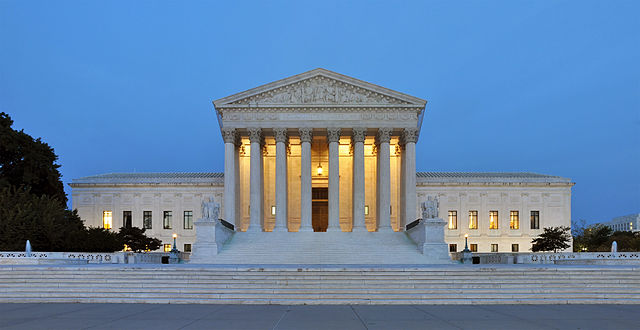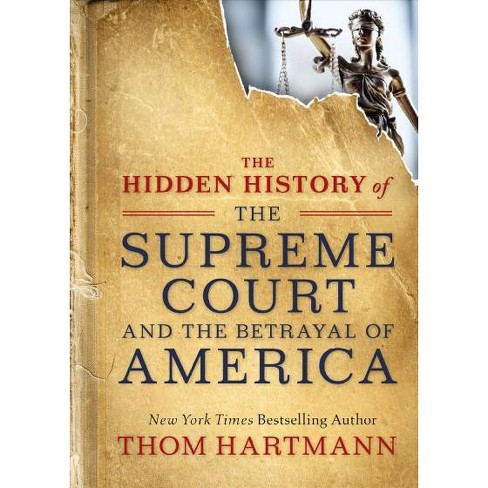By Thom Hartmann | –
(Via Yes! Magazine) – There were those among the founders and framers of the Constitution who didn’t mean for the Court to have as much power as it does today—Thomas Jefferson among them. My new book The Hidden History of the Supreme Court and the Betrayal of America dives into the philosophies that guided the men who drafted the Constitution. It also shows how in 1803, the Supreme Court set itself above Congress and the president with the power to review, strike down, or rewrite laws based on its own lone interpretation of the Constitution.
Importantly, the framers of the Constitution gave no consideration to “the rights of nature” or even of the environment, other than its sheer productive potential to enhance the wealth of the nation. When the Constitution was written in the summer and fall of 1787, the new thing in political circles was the idea of property rights for commoners, which had only clearly been articulated outside of the realm of royal prerogatives during the previous few centuries.
John Locke wrote in his 1689 Two Treatises of Government that the main purpose of government was to make sure that “No-one may take away or damage anything that contributes to the preservation of someone else’s life, liberty, health, limb, or goods.” He was speaking directly to the new ability of some commoners to actually claim title to things, including their own bodies.
After 1,000-plus years of either the monarch or the church (or both) wielding absolute rule and absolute ownership of everything, Locke was pushing a radical and revolutionary idea.
In his chapter titled “Political or Civil Society,” Locke noted that both the laws of nature and the laws of a civilized society would give the right of “life, liberty and possessions” to every man.
If that language seems familiar, it’s because Locke is the man Thomas Jefferson plagiarized, or was inspired by, when he wrote in the Declaration of Independence that the purpose of our newly formed government was to provide for “life, liberty and the pursuit of happiness” because we had the right, simply as humans, to “assume among the powers of the earth, the separate and equal station to which the Laws of Nature and of Nature’s God entitle [us].”
A Suicide Pact
By the time Jefferson was writing, a mere century after Locke, the right of “commoners” (at least white male ones; women and people of color were still excluded) to own private property was well established and well recognized, so Jefferson didn’t see the need to restate it. Instead, he replaced Locke’s repeated and varied mentions of different types of property with “happiness.” It was the first time that word ever appeared in the founding documents of any nation.
Thus, the newest revolution in human rights in 1787, brought to North America by Enlightenment philosophers like Jefferson, was the idea of nonwealthy “commoners” having individual property rights—the right to private ownership of things: from the food a person grew; to the land on which they lived; to exerting agency over their own lives, workplaces, and bodies.
The concept of property rights was becoming a core Western philosophy in the 17th and 18th centuries, and one of the core functions of our 18th century Constitution was to protect, regulate, and provide a mechanism to adjudicate those property rights. Without the Stuart monarchies’ losing their absolute power over property rights in the English Civil War of 1642–51 and the Glorious Revolution of 1688, the Industrial Revolution may never have happened. This shift of property rights, including land rights, from the Crown to the people (at least the white male people) created the legal and political floor for the thinking that led to the American Revolution.
But in 1787, the framers weren’t concerned about running out of arable land, clean water, and clean air. And they never imagined a time when several versions of that day’s East India Company would rise up on these shores and take over our political system to their own advantage and to the disadvantage of democracy itself. They were far more worried about how to create a republic in which the government would both protect a person’s right to own property and facilitate his (consideration of women was excluded) enjoyment of it (hence, “the pursuit of happiness”).
Today, all of that is at risk.
The world is facing a climate crisis that could very well end civilization as it’s currently known, and perhaps could even lead to the death of every animal on earth larger than a dog (including humans), as has happened five times in our geologic past. Fossil fuel interests are steering the planet toward those very undesirable outcomes at light-warp speed. If something isn’t done about the climate/carbon crisis, people reading this today might be living in the last generation to experience a stable atmosphere, and thus a stable form of governance, for any foreseeable future.
The Supreme Court has seized the power to decide what is “constitutional,” and it uses that power to strike down or rewrite laws that have been passed by Congress and signed by the president. But because our Constitution doesn’t mention the rights of nature (or even the environment), the Earth’s biosphere is getting short shrift in our legal system—no matter how many laws Congress passes to protect the environment.
Thus, the judiciary has turned our Constitution in the direction of, as Thomas Jefferson feared, becoming a suicide pact.
Corporate America Seizes the Court
In many ways, the looming crisis is one created by the Supreme Court itself.
No legislature, governor, or president has ever suggested that corporations should be considered “persons” for the purpose of constitutional protections, particularly under the 14th Amendment’s equal-protection rights.
No federal or state legislature, no president, and no state governor has ever, in more than 240 years, suggested that billionaires and corporations have a First Amendment “right” to unlimited political bribery. Congress has instead criminalized such behavior repeatedly.
Both doctrines, corporate personhood and money as speech, were simply invented by corporate-friendly Supreme Court rulings (in the 1819–86 era for corporate personhood, and in the 1976–2013 era for money as speech). Their combined effect has been to hijack America’s democratic experiment, concentrating power into the boardrooms of faceless corporations and the summer homes of reclusive billionaires.
How did America’s great democratic experiment end in a functional oligarchy?
As President Jimmy Carter told me some years ago, America is no longer a functioning democratic republic; we’ve devolved into an oligarchy. Most of this crisis is the direct result of the Supreme Court’s use of judicial review.
Political power is now defined by wealth. That means that virtually unlimited political power has been concentrated into the hands of the richest industry in the world, the fossil fuel industry—the very same industry that is endangering every aspect of our modern world with its reckless pursuit of ever-increasing profits.
The corruption that brought us to this point started with a 1971 memo, in which Republican activist Lewis Powell suggested to the US Chamber of Commerce (and the corporations and multimillionaires associated with it) that they should actively involve themselves in politics. They did, and were so successful that Republican presidents now look to petro-billionaire-funded organizations to select judicial nominees for the federal bench, including the Supreme Court.
How did America’s great democratic experiment end in a functional oligarchy? And how can we change course in time to address the planetary crisis of climate change?
In The Hidden History of the Supreme Court,
I describe when and how the Court has ruled in favor of the country’s elite, and how presidents and the people themselves have occasionally gone to war with the Court—and won. Then I present constitutionally available solutions for Americans to rein in the Supreme Court and claw back our democracy from the hands of billionaires and corporations— including one particularly startling “emergency” solution suggested by Chief Justice John Roberts when he worked for Reagan.
This edited excerpt from The Hidden History of the Supreme Court and the Betrayal of America by Thom Hartmann (Berrett-Koehler 2019) appears by permission of the author.




 © 2025 All Rights Reserved
© 2025 All Rights Reserved